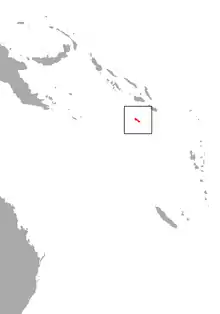Rennell flying fox
The Rennell flying fox (Pteropus rennelli) is a species of flying fox found in the Solomon Islands. It is an endangered species risking extinction.
| Rennell flying fox | |
|---|---|
| Scientific classification | |
| Domain: | Eukaryota |
| Kingdom: | Animalia |
| Phylum: | Chordata |
| Class: | Mammalia |
| Order: | Chiroptera |
| Family: | Pteropodidae |
| Genus: | Pteropus |
| Species: | P. rennelli |
| Binomial name | |
| Pteropus rennelli Troughton, 1929. | |
 | |
| Rennell flying fox range | |
| Synonyms | |
| |
Taxonomy and etymology
It was described as a new species in 1929 by Australian mammalogist Ellis Le Geyt Troughton.[2] As the genus Pteropus is speciose, it is divided into closely related species groups. The Rennell flying fox is in the "samoensis" species group.[3] Its species name "rennelli" comes from Rennell Island, which is part of the Solomon Islands.[4] Rennell Island was where the holotype was collected, and remains the only known location of this species.[1][2] In 1962, Hill published that he considered Rennell's flying fox as a subspecies of the Solomons flying fox, with a trinomen of Pteropus rayneri rennelli.[5]
Description
The forearm of the holotype was 121 mm (4.8 in) long. The fur of its back is uniformly brownish, with the fur of its neck and face lighter.[2]
Biology
Females give birth to one offspring per litter, with the young called a "pup." Its lifespan is estimated at eight to nine years. It is nocturnal, roosting in sheltered places such as trees during the day. Individuals roost by themselves.[1]
Range and habitat
It is only known from Rennell Island, which is part of the Solomon Islands.[1]
Conservation
The holotype was the only known individual of these species until 1958, when two more were collected.[5] It is currently listed as an endangered species by the IUCN; its 2017 assessment uplisted it from its 2008 status of vulnerable.[1] A 2016 study stated that the Rennell's flying fox is one of the land mammals most threatened by overhunting.[6] Because the species has such a small range, it is susceptible to extinction via natural disaster; a single cyclone could conceivably extinct this species.[1]
References
- Lavery, T.H. (2017). "Pteropus rennelli". IUCN Red List of Threatened Species. 2017: e.T136685A22038028. doi:10.2305/IUCN.UK.2017-2.RLTS.T136685A22038028.en. Retrieved 19 November 2021.
- Troughton, Ellis Le Geyt (1929). "A new fruit bat (Pteropus rayneri Group) from the Solomons" (PDF). Records of the Australian Museum. 17 (4): 193–198. doi:10.3853/j.0067-1975.17.1929.761.
- Almeida, Francisca C; Giannini, Norberto P; Simmons, Nancy B; Helgen, Kristofer M (2014). "Each flying fox on its own branch: A phylogenetic tree for Pteropus and related genera (Chiroptera: Pteropodidae)". Molecular Phylogenetics and Evolution. 77: 83–95. doi:10.1016/j.ympev.2014.03.009. hdl:11336/12485. PMID 24662680.
- Beolens, B.; Watkins, M.; Grayson, M. (2009). The eponym dictionary of mammals. JHU Press. p. 339. ISBN 9780801895333.
- Hill, J. E. (1962). "A little-known fruit-bat from Rennell Island". The natural history of Rennell Island, British Solomon Islands. Vol. 4. Copenhagen, Denmark: Danish Science Press. pp. 7–9.
- Ripple, William J; Abernethy, Katharine; Betts, Matthew G; Chapron, Guillaume; Dirzo, Rodolfo; Galetti, Mauro; Levi, Taal; Lindsey, Peter A; MacDonald, David W; Machovina, Brian; Newsome, Thomas M; Peres, Carlos A; Wallach, Arian D; Wolf, Christopher; Young, Hillary (2016). "Bushmeat hunting and extinction risk to the world's mammals". Royal Society Open Science. 3 (10): 160498. doi:10.1098/rsos.160498. PMC 5098989. PMID 27853564.
